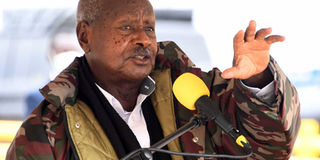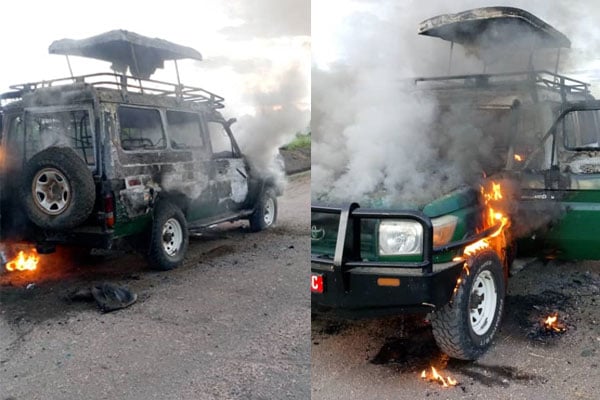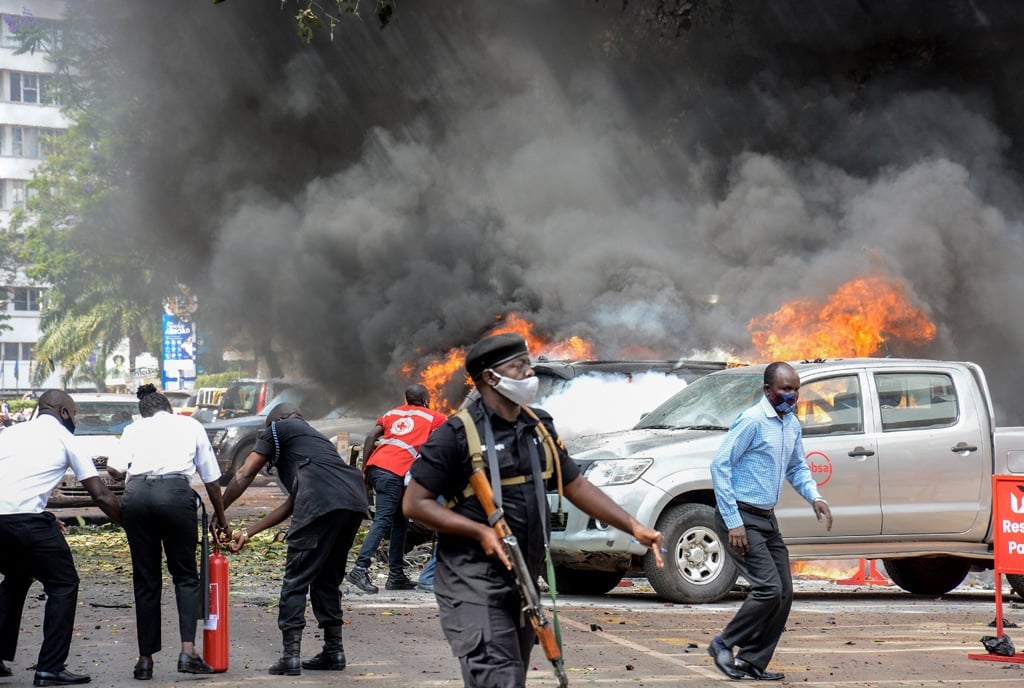Prime
Terrorists who attacked tourists will pay with their wretched lives- Museveni

President Museveni
What you need to know:
- The tourists who were reportedly newlyweds and visiting Uganda for their honeymoon are said to have been attacked and killed alongside their Ugandan driver by suspected Allied Democratic Forces (ADF) rebels at Nyamunuka along Katwe- Kabatooro road in the Queen Elizabeth National Park in western Uganda district of Kasese.
President Museveni has described the Tuesday evening attack that left two foreign tourists and their Ugandan driver dead at one of the biggest national parks in western Uganda as a “cowardly act”, vowing to make the assailants “pay with their own wretched lives.”
The tourists who were reportedly newlyweds and visiting Uganda for their honeymoon are said to have been attacked and killed alongside their Ugandan driver by suspected Allied Democratic Forces (ADF) rebels at Nyamunuka along Katwe- Kabatooro road in the Queen Elizabeth National Park in western Uganda district of Kasese.
“Our High Commission in the UK will reach out to their families and provide whatever support is necessary in this tragic situation. More importantly, the UPDF, the Police, the UWA and Intelligences should ensure these mistakes do not happen again and that ADF is wiped out. The wiping out is moving very well. What needs to be done is to ensure that the remnants do not commit these atrocities. That is why I congratulate, again, the Wanainchi, the Police and other agencies on preventing the bombing of Bunamwaya, Kayanja’s church and the churches in Kibibi, Butambala,” President Museveni posted on his X (formerly Twitter) handle on Wednesday.
Queen Elizabeth Park shares a border with DRC and its renowned Virunga National Park, a habitat for rare mountain gorillas, and where armed groups are believed to operate.
According to Mr Museveni, there are still some gaps which the ADF remnants “running away from our operations in Congo” exploited to stage the attack in the park in Uganda.
“UWA was guarding tourists once they were in the Park. However, apparently, the tourists were arriving and departing individually. It is this gap that they used,” Mr Museveni explained.
The UPDF has reportedly been using one form of tracking the fugitive groups from the DR Congo by following their tracks, according to the president.
“There are more reliable ways of tracking, which we have discussed with the army. The terrorists will be defeated like [LRA’s Joseph] Kony was defeated and the cattle rustlers that have been killing people in Karamoja [sub region] and the surrounding districts or those that were cutting people with pangas (bijambiya) in Masaka,” Mr Museveni added.
The ADF is historically a Ugandan rebel coalition whose biggest group comprised Muslims opposed to veteran President Yoweri Museveni.
Established in eastern DRC in 1995, the group became the deadliest of scores of outlawed forces in the deeply troubled region.
It has been blamed for massacres, kidnappings and looting, with a death toll estimated in the thousands.
This is not the first time tourists are being attacked in Queen Elizabeth National Park.
On April 2, 2019, American tourist Kimberly Endicott and her guide Jean-Paul Mirenge were kidnapped by suspected terrorists at QENP. The government paid ransom for their release five days later.
The Tuesday attack comes days after President Museveni said on Sunday that security forces had foiled a bomb attack on churches by ADF rebel group.
The ADF made two bombs, which they "were planning to plant in churches in Kibibi, Butambala", Museveni wrote on X, formerly Twitter.
But the devices "were reported to police and defused", he added.
The ADF group has pledged allegiance to the Islamic State group.
On Friday last week, at 1am, a group of about five suspected ADF individuals torched a Mercedes Benz vehicle, killing two people and leaving one injured.
The deceased were identified as Mr Joseph Matovu, the driver and a resident of Kyengera in central Uganda’s Wakiso District and Ms Claris Nzoghera Biira, a resident of Nyakahya village. Ms Alicen Magezi of Kinaba in Kisoro, sustained injuries. Only Ms Edreda Biira, from Rugendabara-Kikongo Town Council survived without injuries.
This is the third time suspected ADF terrorists have crossed into Kasese since the tragic June 16 raid on Mpondwe-Lhubiriha Secondary School in which 38 students and six locals were hacked to death and set ablaze.
Amid these incursions, President Museveni has kept up a running commentary on successful army operations inside the Congo even as he warned that ADF are trying to re-enter Uganda because of the intensity of the UPDF’s Operation Shujaa being conducted alongside Congolese forces.
On October 15, President Museveni posted on his X handle indicating that Ugandan fighter bombers hit four ADF targets inside DRC located between 69 and 130 km from the border.
As a consequence, President Museveni said the terrorists were running from Congo. “The public is, therefore, alerted to look out for strange people that come to you. Report them to the police that are nearest to you. Even relatives who have been away for a long time and suddenly return. They may be part of the terrorists,” President Museveni said.
In September, police said they had foiled another bomb attack on a Kampala cathedral, arresting a man suspected of trying to activate the explosive device among worshippers.
In June, ADF militia members killed 42 people including 37 students in a high school in western Uganda near the border with DR Congo.
It was one of the deadliest attacks in Uganda since the 2010 double attack in Kampala that killed 76 people in a raid claimed by the Somali-based Islamist group al-Shabaab.
In its latest report in June, a United Nations expert panel on DR Congo confirmed ISIS had "provided financial support to the ADF since at least 2019".
How 8 tourists died in 1999 Bwindi massacre
The horrific attack unfolded in the early hours of March 1, 1999 when suspected Rwandan Hutu death squads (Interhamwe rebels) raided a tourist camp in Bwindi Impenetrable Forest National Park, southwestern Uganda, abducting 14 tourists and their Ugandan guide.
After a forced march through the jungle, all captives were bludgeoned and hacked to death.
Amid worldwide condemnation of the shocking atrocity, surviving eye-witnesses described how the victims; four men and four women, were murdered with machetes and axes as they were frog-marched towards the border with the Democratic Republic of Congo (DRC).
The rebels had separated those who spoke English, taking 14 people from a group of about 30 tourists in the camp who they forced to remove their shoes. The rebels killed the park guide by pushing him under a truck and setting it on fire.
In the aftermath, the victims were identified as Americans Rob Haubner and his wife, Susan Miller; Rhonda Avis and Michelle Strathern from New Zealand; Britons Martin Friend, Steven Robert, Mark Lindgren, Joanne Cotton, and Ugandan guide Ross Wagaba.
Ms Miller is believed to have been raped before she was brutally killed.
It is believed that about 150 heavily-armed interahamwe rebels hit the Bwindi camp just before 7am on Monday, March 1, 1999 after a second group first created a diversion, drawing Ugandan troops stationed nearby away.
According to survivors’ accounts, soon after leaving the camp one of the women fell behind and was led away by rebels. An hour or so later another two women could not keep up and were also led away. Around 12 p.m. three of the men were separated from the main group. All were led away to be butchered.
Shortly before 4pm the rebels and their remaining captives reached the DRC border. After a brief argument, the rebels then simply melted into the jungle. The captives then walked back and after about 40 minutes met pursuing Ugandan soldiers, survivors said.
But before abandoning the captives, the group had handed a note to a French diplomat, who was among those who had been taken, in which they said English-speakers were targeted because of US and British support for the Tutsi-led Rwandan government headed by Gen Paul Kagame.
The Bwindi massacre dealt a crippling blow to Uganda’s tourist industry, particularly in Bwindi which is home to half of the world’s 600-plus mountain gorillas remaining in the wild.
Years later in 2006, Jean-Paul Bizimana, one of the interahamwe rebels, was brought to trial in the High Court of Uganda.
On January 16, 2006, Judge John Bosco Katutsi sentenced Bizimana to 15 years in prison, one week after convicting him for killing the tourists and their Ugandan tour guide.
Bizimana had been first arrested in 1999 and detained until 2001 on suspicion that he was involved in the Bwindi massacre. He was then released and reportedly deployed as an enemy asset embedded with Ugandan troops operating in the eastern DRC. He worked with the UPDF until Uganda withdrew from the Congo in 2003.
He was seeking asylum in Uganda when he was re-arrested in 2005 near the Rwandan border.
Three other suspected interahamwe were arrested earlier in 2003 and shipped off to the US to stand trial for the deaths of the Americans. They were identified as Francois Karake, 38, aka Rafiki; Gregoire Nyaminani, 32; and Leonidas Bimenyimana, 34, aka Zappy Gaddi.




